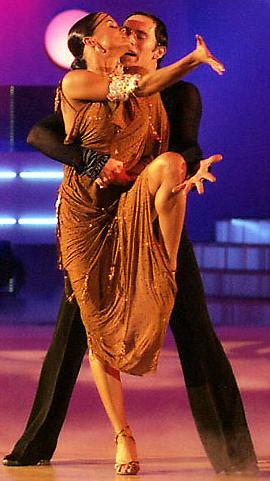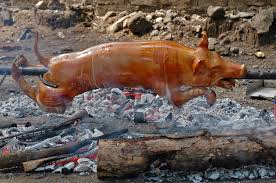The RUMBA dance
There are a wide range of Latin dances that originated in Latin America and Cuba. Some of these famous dances are Tango, Samba, Cha-cha-cha, Salsa, Mambo, Rumba, danza, Bachata, Merengue, Cumbia, Tumba, and Bolero. When you say Latin dance, it might mean two things, depending on how it is used as reference to social or ballroom dance.
For now, we will be focusing with the Latin dance, called RUMBA. It is thought that the Rumba dance has two meanings in it. It is cited as a Cuban event with an African style and it is said that the most widely used rumba version is known as guaguanco. But this is the old-style rumba.
The Rumba dance is also famous in ballroom dances and other international dance competitions. It is basically a social dance that derives its movements and music with what they call the son music, in which the structure and elements of Spanish canción and the Spanish guitar with African rhythms and percussion instruments are combined.
It is said that the Afro-Cuban Rumba is different from that of the ballroom rumba version. The modern style of dancing rumba is derived from studies of Cuba by international teachers. It is known to be the slowest dance among the established five Latin dances in the international competitions.
The bolero-son is the old Cuban musical rhythm that is used to accompany the Rumba dance. It is a very classy but sexy dance that includes swaying of the hips while standing over one leg though it is executed in a slow movement that gives emphasis to swaying of the body.
The Rumba dance became popular in the 1930s even up to now with its complex scoring game in international Latin dance competitions.
The video below will be featuring how the Rumba dance is executed. It takes a lot of practice to learn how t dance the Rumba way. It takes a lot of sexy hips swaying with the slow music accompaniment.
You may try to visit http://www.rumbaroom.com/ for the latest gigs and updates on the Rumba dance. I’m sure those fanatics will definitely have fun hanging out online and meeting people of the same interest. This exclusive group club is an online avenue for those who are interested to know anything about the rumba dance. You will have access to concerts, events, photo gallery and it is an interactive site for its members and readers.
The Puerto Rican cuisine is one of the most delightful menus that one could taste. It is a blend of ingredients, recipes, cultures and food set up. It has its roots in Spanish and Caribbean cuisine but it has its own distinct style and taste. Will be featuring five palatable dishes to delight your taste buds this holiday season!
1. Mofongo If is a famous dish in Puerto Rico. It is a concoction of mashed plantain, food seasonings, and fillings such as shrimps, steaks, pork, vegetables, etc. You can find it at any Puerto Rican restaurant, sidewalk food stalls, or the locals themselves might have their own recipe version of it.
If is a famous dish in Puerto Rico. It is a concoction of mashed plantain, food seasonings, and fillings such as shrimps, steaks, pork, vegetables, etc. You can find it at any Puerto Rican restaurant, sidewalk food stalls, or the locals themselves might have their own recipe version of it.
2. Lechon/Roasted Pig This is a very irresistible delicacy that you have to experience eating it. It’s a popular festive pork dish known as roasted suckling pig. You can have it sweet or spicy or a combo of both flavor options. You may visit Guavate where they have a place called, Ruta del Lechón, a popular lechon territory where the best tasting lechons are. Give it a try!
This is a very irresistible delicacy that you have to experience eating it. It’s a popular festive pork dish known as roasted suckling pig. You can have it sweet or spicy or a combo of both flavor options. You may visit Guavate where they have a place called, Ruta del Lechón, a popular lechon territory where the best tasting lechons are. Give it a try!
3. Arroz con gandules This is actually the national dish of Puerto Rico. It is called pigeon peas with rice and is made with pork, ham, bacon, chorizo, red peppers, olives and other spices to taste. Puerto Ricans have their own way of serving it to make it distinct from other cuisines. They have their secret sauce that adds flavor to the dish the Puerto Rican way. Another variation of the dish is called arroz con habichuelas. You may want to explore that dish as well.
This is actually the national dish of Puerto Rico. It is called pigeon peas with rice and is made with pork, ham, bacon, chorizo, red peppers, olives and other spices to taste. Puerto Ricans have their own way of serving it to make it distinct from other cuisines. They have their secret sauce that adds flavor to the dish the Puerto Rican way. Another variation of the dish is called arroz con habichuelas. You may want to explore that dish as well.
4. Asopao It’s a homemade chicken soup with rice. It’s a dish loved by many islanders as they usually remember their moms cooking the savory soup for them. It’s obviously a popular menu in any local restaurant in Puerto Rico and each chef has their own recipe variations with pork, shrimp, seafoods, beef or vegetables on it.
It’s a homemade chicken soup with rice. It’s a dish loved by many islanders as they usually remember their moms cooking the savory soup for them. It’s obviously a popular menu in any local restaurant in Puerto Rico and each chef has their own recipe variations with pork, shrimp, seafoods, beef or vegetables on it.
5. Fritters, Alcapurrias, Cuchifritos These are just a few of the fried foods in Puerto Rico. It’s available in any restaurant that you may happen to sit in. Alcapurricas is like a fried turnover version. It’s perfect for an after meal or a dessert substitute. They have yam fritters called buñuelos and cheese-flavored rice fritters called almojábanas. You have lots of these selections.
These are just a few of the fried foods in Puerto Rico. It’s available in any restaurant that you may happen to sit in. Alcapurricas is like a fried turnover version. It’s perfect for an after meal or a dessert substitute. They have yam fritters called buñuelos and cheese-flavored rice fritters called almojábanas. You have lots of these selections.
So, it’s just a few days to go before Christmas! Have you thought of dishes to serve on your tables for you to feast on? C’mon, ask your grandma’s recipes for those foods. That might be a good cookbook reference. Or as we all know, moms know best! Happy Holidays!
The Christmas holiday is near and people in different parts of the world will have its own way of celebrating. The Puerto Rican Christmas version is known as Navidad. This is the day of Christmas-December 25 where Christians celebrate the birthday of Jesus. It is thought that Santa Claus will be bringing gifts to kids in which the custom originated in the USA way back 1940’s and now has become Puerto Rico’s Holiday tradition. Navidad is the time of tradition, aguinaldos, décimas, y de ser jíbaro Puertorriqueño which is the best of Puerto Rican culture.
Puerto Rican Food
Puerto Ricans begin their Christmas celebrations early in December and perhaps would end on the first week of January. Of course, this is the best time to talk about Puerto Rican food. The Puerto Rican cuisine is similar to that of Spanish, Mexican, and Cuban with a delightful blend of African, Taíno, and American influences.
Nochebuena is a special dinner party done on Christmas Eve. Puerto Ricans like chicken so you would always see as part of the main dish, like baked chicken or turkey, and roasted pork or ham which is accompanied by Spanish rice with pigeon peas, local vegetables like cooked green bananas, fried plantains or cooked yam.
Some of the Puerto Rican food appetizers during dinner generally includes with sizzling-hot appetizers such as bacalaitos, crunchy cod fritters; surullitos, sweet plump cornmeal fingers; and empanadillas, crescent-shaped turnovers filled with lobster, crab, conch, or beef. It is also thought that soups are a popular beginning for meals on Puerto Rico just like in other countries. There is a debate about whether one of the best-known soups, frijoles negros (black-bean soup), is Cuban or Puerto Rican in origin. Nevertheless, it is still a savory, if filling, opening to a meal. For their Holiday desserts, they have "arroz con dulce" (rice cooked with spices, sugar, milk, and coconut milk) and "tembleque" (a custard made with cornstarch, sugar, and coconut milk). They taste better cool down or cold, when its consistency becomes more solid. One for the festive Puerto Rican food is the lechón asado, or barbecued pig, which is usually cooked for a party of 12 or 15. It is traditional for picnics and al fresco parties. These are just one of the Puerto Rican food serve during holidays.
Despedida de Año is celebrated on December 31 in time to end the year and face and new one. The biggest and most important for all children is what they call, el Día de Reyes on January 6th. This is the day when Puerto Rican children open their gifts the night before the Three Wise Men (Kings) left.
The Puerto Rican Christmas Party
The Puerto Rican Christmas is different as they have a special “pava” (traditional straw-hat) to be worn just for Christmas. They have their own version of Christmas caroling which they call Parranda. It is when a small group of folks gathers to surprise another folk and they will be bringing their musical instruments like either guitarras, tamboriles, güiro maracas, or palitos in which they will play the traditional Aguinaldos (Puerto Rican Christmas songs).



